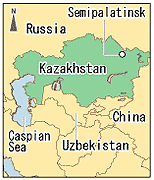(13)Nuclear weapons and a growing friendship by Sadykova Madina Maratovna
Hello, I'm one of the junior writers, Madina Sadykova. I'm from Kazakhstan and I returned to my country at the beginning of March to study for university entrance exams. For this issue, I'd like to tell you about the links between my hometown and Hiroshima, such as the "Hiroshima-Semipalatinsk Project" which gave me the opportunity to study in Japan.

Madina talking with a friend at her farewell party in February
Madina Sadykova
Born in Kazakhstan. While a high school student in the city of Semipalatinsk, she was invited to Hiroshima last April and studied at Sanyo Girls High School for one year. She was working as a junior writer for Peace Seeds before returning to Kazakhstan.
In my hometown, Semipalatinsk, the former Soviet Union conducted about 470 nuclear tests between 1949 and 1989. Many people were affected by these tests, like the A-bomb survivors of Hiroshima.
When Hiroshima held the Asian Games in 1994, one of the activities involved each community center in the area cheering for one of the participating countries. As it turned out, a community center located in Hiroshima cheered for the athletes from Kazakhstan. After the Asian Games, this community center continued their support of Kazakhstan. One of their projects has enabled students to study in Hiroshima; so far, 13 in all, including me.
Other support has included health check-ups by a visiting medical team as well as donations of medical equipment and medicine.
To be invited to Hiroshima, I first had to study Japanese for two years and pass an exam. I was then a student at Sanyo Girls High School for one year, starting in April 2006. I lived in a dormitory and made many Japanese friends. Moreover, I had the chance to meet a number of A-bomb survivors and hear their stories. As I began writing for Peace Seeds, their experiences helped me understand the horror of atomic bombs and the importance of peace.

For me, the Peace Memorial Ceremony on August 6th was very impressive. Kazakhstan doesn't have such a peace ceremony to pray for peace and I felt my country should follow Hiroshima's example.
For this issue, I interviewed Urazalin Marat, 64, the Vice-President of Semipalatinsk Medical University. He represents the Semipalatinsk branch of an anti-nuclear test group that was founded in 1989 and he has been to Hiroshima four times.
The first time Mr. Marat visited Hiroshima, in 1994, he thought, "It's hard to believe this was the place that had been bombed." But after visiting Peace Memorial Museum and listening to the survivors' stories, the reality of the tragedy sank in. He told me, "The people of Hiroshima and Kazakhstan have begun a friendship that I hope will grow for generations to come."
I feel the same way.